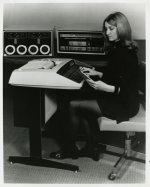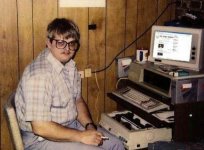monkeybear, can you characterize in words the difference in sound that you hear??
especially in sibilence and things like cymbals - and maybe any other tonal changes?
especially in sibilence and things like cymbals - and maybe any other tonal changes?
I wish this were true. Once you get the power supply rectification and regulation cleaned up all these effects of passives start making themselves known. One example: The type of resistor on the 4th pole of a RIAA network can make or break the dynamics of the top end. Also feedback resistor and stopper resistor types play a big part. If they don't in your circuit, then you have more work to do on getting the power supply out of the way.Then theres the 'small stuff' - certainly a factor. Passive components don't match their theoretical ideal for example. For me the thing is, the effects can be so subtle that its very difficult to tell them apart from psychological effects. I'm not at all saying its all placebo, but I do think its a tricky area and people passionately disagree! 🙂 I believe people have done blind tests and that sort of thing but I dont know much about it. Does anyone know anyone have any good examples of that kind of thing?
To hear 0.00003% difference in thd I think is impossible. but if You can why not take part that measures better, little here little there and You have 0.01% better thd on end of line,simple why not.
Something like noise, if You hear noise You know its not good, but if You dont hear any noise, why care at what level is it when You dont hear it? But still if You can pick part with lower noise why not.
I agree completely, and would like to add that harmonic distortion measurements, done with sine waves, don't represent what can happen with complex audio signals, but they do tell you how an amplifier performs in some simple ways. So, while the actual numbers might be irrelevant, because we rarely listen to static sine waves, I do think that, as long as everything else is competent, a device with less harmonic distortion will sound cleaner than one with higher numbers.
Harmonic distortion is a useful metric because it can be done so well, and when comparing two devices, one less linear and one more linear, it seems clear that the less linear device will score more poorly. So, I think it does correlate to the mechanisms that make equipment sound good or bad. It's maybe not a direct measurement of "good or bad sound", but it does identify real problems that can lead to a bad sounding device.
A story from the '80s. One of the kids on the block had a particular setup where his R2R tape recordings from LPs sounded better than playing the LP directly. Cleaner and more fluid, like it was bringing the music upfront from some noise. It was no illusion, all the kids on the block knew it and could "ABX" it, we tried this many times. And we were all lined up to record our tapes on this magic setup.
Being kids we brought in an identical tape unit and recorded tape-to-tape to see if it improved any better. Nada. Nothing. It just added some more tape hiss and dulled the top end a little bit.
No one had any good explanation on what exactly was happening. Did the tape unit filter out something? Did it add something of its own? Was it some impedance match thing between the phono stage / pre vs. tape inputs? That will remain unsolved I'm afraid.
Being kids we brought in an identical tape unit and recorded tape-to-tape to see if it improved any better. Nada. Nothing. It just added some more tape hiss and dulled the top end a little bit.
No one had any good explanation on what exactly was happening. Did the tape unit filter out something? Did it add something of its own? Was it some impedance match thing between the phono stage / pre vs. tape inputs? That will remain unsolved I'm afraid.
Kirchoff, I did not find that analog recorded vinyl sounded as good as straight vinyl playback. Back in 1967, I bought an Ampex portable mastering deck that recorded at 1/2 track and ran 15ips. I could never get the tape to sound as good as the record, so I gave up. Now, the same analog recorder did mastering rather well, and the GD sometimes used it as a reference, so there was nothing wrong with the analog recorder itself.
The mysteries of vintage audio. Given that the LPs were made from a tape master, they shouldn't have sounded better than tape, eh? 😕
I think we'll never know the reasons why we had these experiences. Maybe if we could get some vintage gear from e-bay, rebuild our old setups, and measure them with contemporary equipment.... but even then, the answer may not be in a few cold numbers.
I think we'll never know the reasons why we had these experiences. Maybe if we could get some vintage gear from e-bay, rebuild our old setups, and measure them with contemporary equipment.... but even then, the answer may not be in a few cold numbers.
The mysteries of vintage audio. Given that the LPs were made from a tape master, they shouldn't have sounded better than tape, eh? 😕
It depends on how hot it was recorded.
Tape saturation produces a very pleasant dynamic compression effect that, subjectively at least, tends to make things sound better.
Once digital took over recording many missed that effect and now there are many plug ins which emulate tape compression more or less successfully.
Turntable carts fitted in music centers etc often used to have a low output. I used to record from them with the level meters kicking into the red, the tape when replayed seemed louder, more dynamic but with more noise. Chrome tape and Dolby C improved things when they came along but i don't miss tape or vinyl.
It depends on how hot it was recorded.
Tape saturation produces a very pleasant dynamic compression effect that, subjectively at least, tends to make things sound better.
The head scratching was because it was this guy's setup that had the most prominent effect, and only at first LP to tape transfer - the other kids couldn't quite replicate it on their setups.
I do remember the effect you mention, particularly the treble started to be "smoothed" at higher volume levels, while at lower volumes it was clear and distinct. Pink Floyd's "Wish You Were Here" album was a good one to make it noticed. "Shine On You Crazy Diamond" let you hear clear and detailed treble then after the crescendo and going into "Welcome to the Machine" the treble on tape was slightly muted (pleasantly so) while directly from LP it was more acid.
And yes, I remember the art of setting the recording volume so that you wouldn't drown "Shine on" in tape hiss, and at the same time you didn't bend the VU needles when "Welcome" started lol ....
And my amazement when I first heard "Welcome" on a more powerful setup, with "ultra bass" and larger speakers.... I instinctively looked through the window for some heavy truck passing on the street and causing vibrations... there was no truck, just those large VU needles pulsing.... oh, the times....
Now that we decided that there's nothing wrong with OPA134 and AD825 (except maybe the SOICness of the AD), who can add to the list a "nothing wrong with" bipolar input stage one? Preferrably PDIP?
Old Geezer Club
I still remember it too. Good ol' time.
How long before someone points out they can still remember the toggle sequence to bootstrap a PDP-8!
Now that I've forgotten even though for a while I had to do it every morning.
I still remember it too. Good ol' time.
Kirchhoff,
There are lots of things not wrong with almost all op amps, but they all have their niches in which they perform best.
For audio, OPA134 is a very benign one in terms of not wanting to dance with every piece of reactance and also because of its rejection of RFI.The LM4562 is rather the opposite, but would have somewhat lower distortion and noise. Never worked with AD825, but based on the spec sheet I would say it is not really optimum for audio, but I am certain it can be made to work very well in those applications.
There are lots of things not wrong with almost all op amps, but they all have their niches in which they perform best.
For audio, OPA134 is a very benign one in terms of not wanting to dance with every piece of reactance and also because of its rejection of RFI.The LM4562 is rather the opposite, but would have somewhat lower distortion and noise. Never worked with AD825, but based on the spec sheet I would say it is not really optimum for audio, but I am certain it can be made to work very well in those applications.
Member
Joined 2009
Paid Member
You guys are older than I - but I am a member of that dubious club that has used the toggle switches to fire up a PDP-8. My high school had one. We loaded up some code which enabled a punched tape reader to operate and it was used to load in a more sophisticated code which enabled the terminal/teletype to work. We could write a simple BASIC program and play with it for awhile before it .... crashed. The magnetic memory core elements were large enough to see with the naked eye.
Actually, I can't be sure it was a PDP-8, to be honest I don't remember what it was called. But it stood there as big as a vending machine.
Actually, I can't be sure it was a PDP-8, to be honest I don't remember what it was called. But it stood there as big as a vending machine.
Last edited:
And in Octal, which I don't think I ever used again in anger.
All later 16(+) bit engines used Hex.
All later 16(+) bit engines used Hex.
Member
Joined 2009
Paid Member
I kind of miss the style of the equipment from back then - this teletype terminal is real sleek.
The IBM PC destroyed it all.... 😡
Attachments
Cherry keys are still made, and used in for example Das Keyboard - The Ultimate Mechanical Keyboard Experience for Badasses . My daughter has the ultimate. Still not quite as noisy as the classic IBM terminals though.
- Status
- Not open for further replies.
- Home
- General Interest
- Everything Else
- What is wrong with op-amps?


